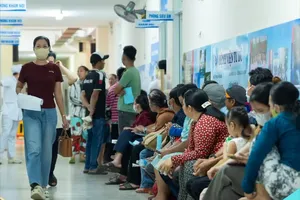
Deputy Director Nguyen Van Vinh Chau of the HCMC Department of Health highlighted the city's efforts to address the low birth rate in the city. The HCMC People’s Committee has devised the comprehensive plan for population work in 2024, aiming to increase the birth rate, balance the sex ratio at birth, enhance population quality, improve the health of the elderly, and take better advantage of the golden population period for socio-economic-cultural growth.
The city has set a target of 1.36 children per woman and aims to increase the crude birth rate (CBR) by 0.5 points per thousand compared to 2023. Additionally, HCMC is targeting an 82-percent newborn screening rate, an average life expectancy of 76.5 years, and comprehensive management of all pregnant women and newborns.
Long-term strategies include a proposed plan to increase the total fertility rate and improve the health of pregnant women, newborns, and children. This plan outlines eight objectives and recommends policies to encourage couples to have two children. Factors such as labor, employment, housing, social welfare, education, and healthcare will be considered when formulating these policies. They are supposed to contribute to stabilizing the population scale and improving the demographic quality of the city in the future.
Director Pham Chanh Trung of the city’s Population and Family Planning Agency emphasized the challenges posed by a low birth rate. A rapidly aging population places increased pressure on social welfare systems (pension, health insurance, social allowance, public entertainment facilities), while a declining workforce can hinder economic growth.
To address this demographic crisis, HCMC is drawing inspiration from other countries. China has relaxed its one-child policy, while Singapore offers financial incentives for families with multiple children. Japan has implemented policies to support families with three or more children, including free university education.
HCMC is also strengthening its efforts in family planning and health education. The city is collaborating with various state departments and organizations to provide pre-marital counseling and health check-ups for city dwellers, particularly vulnerable people; to organize competitions among high schoolers to raise their awareness about population issues and pre-marital health check-ups.
Director Khuat Thu Hong of the Institute for Social Development Studies highlighted the need for comprehensive policies. While existing support programs for pregnant women and families are beneficial, factors such as high living, medical, and educational costs, unstable income, long working hours, insufficient medical and educational infrastructures in industrial parks and export processing zones can deter couples from having children.
The draft Population Law, currently under review, proposes various incentives, including financial rewards for couples with two or more children, especially in exceptionally low-birth-rate areas. However, experts argue that these incentives alone may not be sufficient to address the underlying issues as they are too low compared to the real expenses to raise a child in large cities. Long-term childcare supports are also needed to boost the growth of this important rate.
In response to a constituent's inquiry regarding policies to support couples who have two children, including benefits such as social housing, rental assistance, and priority enrollment in public schools, Minister of Health Dao Hong Lan provided a comprehensive response.
She referenced Decision 588/QD-TTg, issued on April 28, 2020, which approved a program to adjust birth rates to suitable levels by 2030. The decision outlines specific measures to encourage couples to have two children, particularly in areas with low birth rates:
- Policy adjustments: This involves removing regulations that discourage having more than two children and introducing new policies that incentivize couples to have two children.
- Local government initiatives: Local authorities are encouraged to implement support measures such as affordable housing, rental assistance, priority enrollment in public schools, and school fee aid for families with two children.
- Public awareness campaigns: Efforts will be made to educate the public about the socio-economic benefits of having two children and the negative consequences of late marriage, delayed childbearing or having fewer children.
- Expanded access to healthcare services: The government will focus on providing comprehensive reproductive health services and addressing infertility issues from early age.
- Revision of population laws: The Ministry of Health is drafting a new Population Law to replace the 2003 version. This new legal document will grant couples the right to decide voluntarily and responsibly on matters related to childbearing. It is supposed to tackle extremely low birth rates as experienced in other nations in the world, which has had negative impacts on socio-economic growth and national defense and security.
























